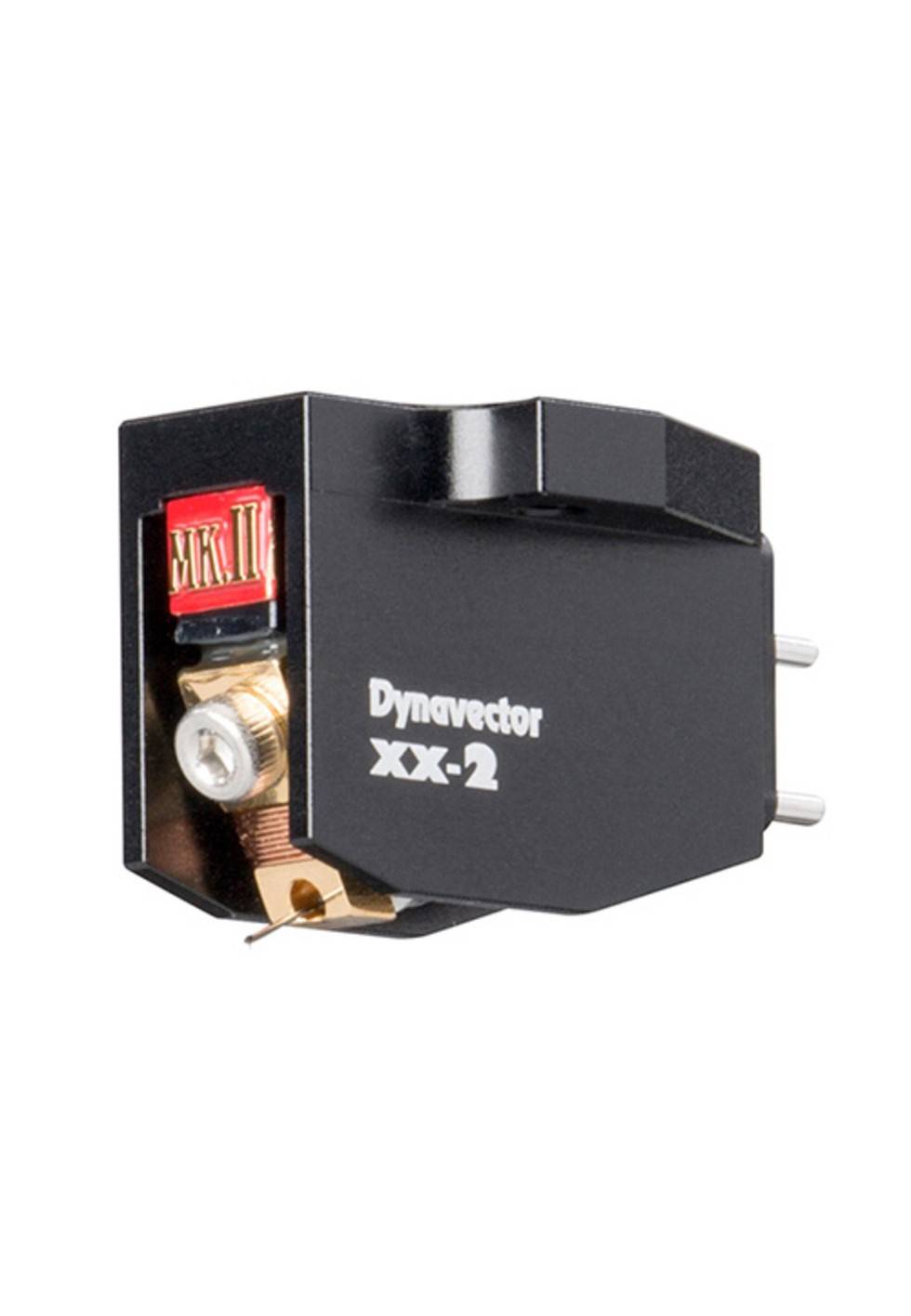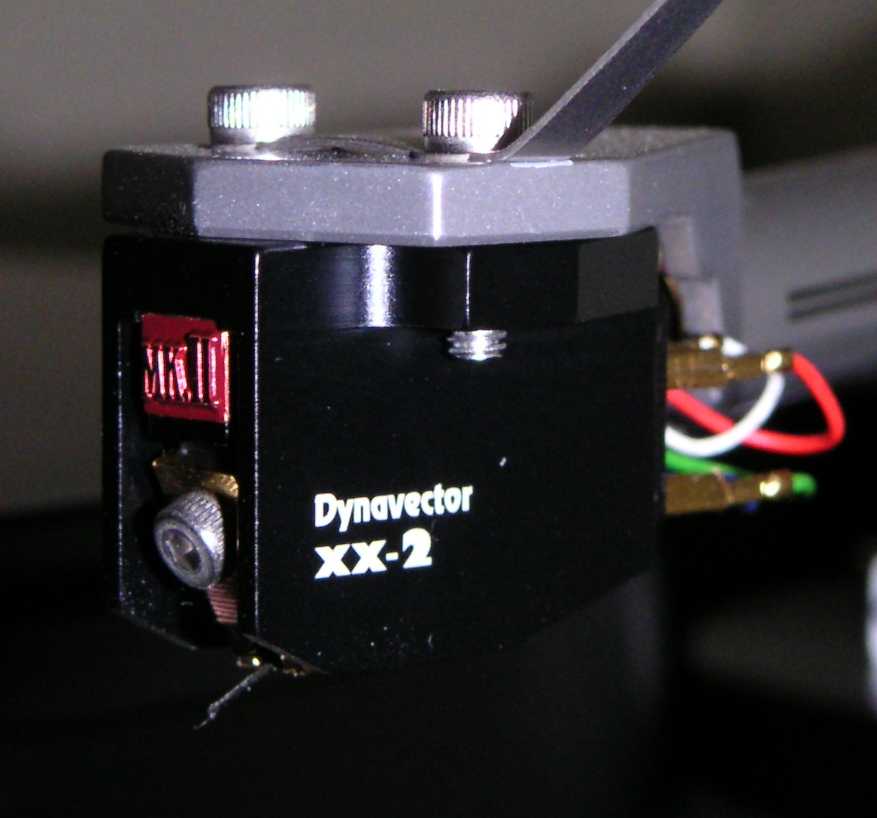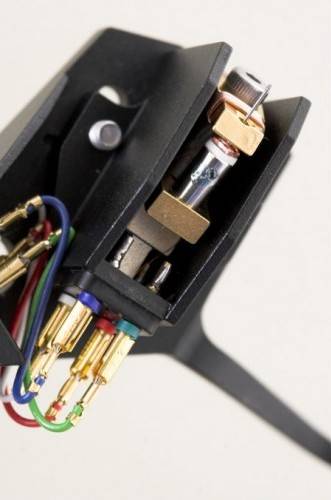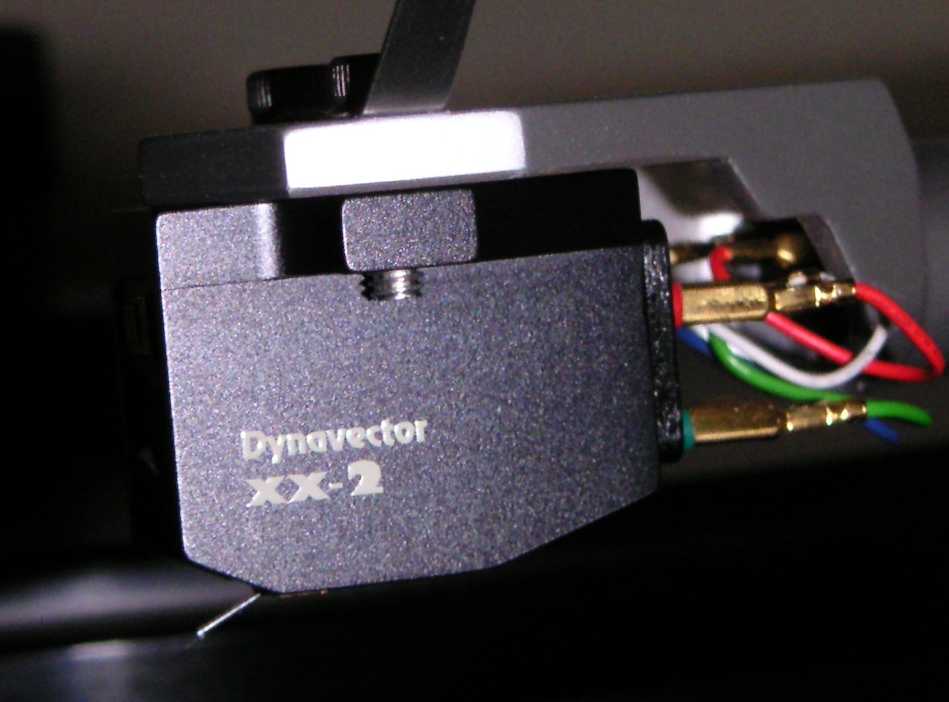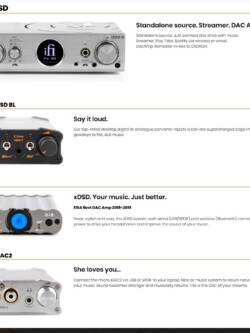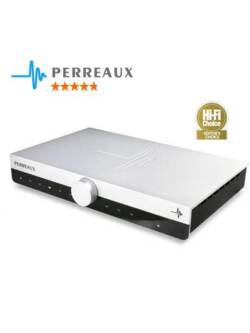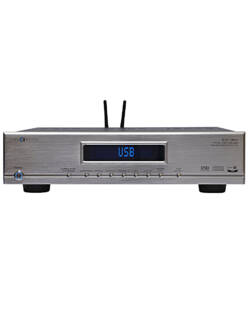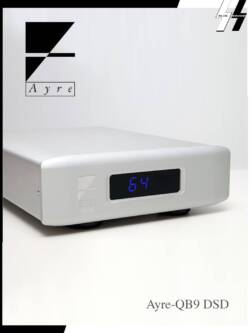Dynavector XX-2 MkII MC Phono Cartridge
Original price was: R54,000.00.R26,000.00Current price is: R26,000.00.
$2150 (R54000 landed after taxes)
This is a NEW, Official cartridge from the Importer!, valid for 1st two cartridges 🙂
Introduction
Regular readers will have seen my review of the Dynavector DRT-1 cartridge. As objects of desire go it’s high on my personal list. However it has two problems – firstly its sheer cost puts it beyond the reach of all but the most dedicated audiophile, secondly it’s a big, heavy cartridge. Although my own SME IV coped admirably – having a big enough ‘headshell’ to physically accommodate the beast and easy height adjustment for its taller-than-usual build – it did need it’s counterweight racked well back to balance the 13.5 grm mass.
![[XX-2]](https://www.tnt-audio.com/jpg/xx2small.jpg) For many vinyl addicts with high-end equipment the DRT will be a non-starter for this reason. Unipivots in particular will struggle. I recently read a review of the DRT in a British hi-fi magazine that concluded it was an awesome cartridge but did mention it was a little lightweight in the bass. Reading the text soon showed why, the poor thing was dangling on the end of a WTA arm, a superb design but obviously in trouble with the DRT – my own experience with the SME showed the DRT to have massive bass power and control.
For many vinyl addicts with high-end equipment the DRT will be a non-starter for this reason. Unipivots in particular will struggle. I recently read a review of the DRT in a British hi-fi magazine that concluded it was an awesome cartridge but did mention it was a little lightweight in the bass. Reading the text soon showed why, the poor thing was dangling on the end of a WTA arm, a superb design but obviously in trouble with the DRT – my own experience with the SME showed the DRT to have massive bass power and control.
Another interesting point about the DRT is that it bares no resemblance at all to the rest of the Dynavector range, it’s a ‘statement product’, which stands alone and this no doubt contributes to its cost.
Enter the XX-2. This is based on the XX-1 but with the body removed and replaced by a superb cast Aluminium ‘skeleton’. In fact it resembles the Dynavector Te Kiatora (TK) rather closely. This is a joint effort between Dynavector Japan and New Zealand and like the XX-2 is loosely based on a stripped down XX-1. The differences between the two seem to be the use of a titanium block as the base-plate of the TK rather than the aluminium chassis of the XX-2 (the former better suited to short runs, the latter to ‘production’), the use of silver coils on the TK (both XX-2 and DRT-1 use copper) and the use of superior Alnico magnets on the XX-2. From a technical point of view it looks like the XX-2 is a ‘productionised’ TK at a considerably lower price. It also runs out at only 40% the cost of a DRT-1 making it much more accessible. Perhaps more important, at 8grms (the TK is 8.8grms) and of normal dimensions it is also widely compatible with any quality tonearm
Technical
I’ve covered much of this already, but it’s a low (0.25 mv) output MC of medium compliance. The cantilever and stylus are the Boron/PF line-contact combination shared by the two other top Dynavectors. The alloy ‘body’ is threaded for mounting bolts and a slightly dodgy stylus guard is supplied making fitting slightly less heart stopping than with the DRT-1… This also acts as a guide when aligning the cartridge. The paint finish on the body is a perfect match for both my SME and the Orbe making it a sexy looking combination…
Once bolted up it gave an arm/cartridge resonance of 9 hz, much like the DRT and well within the acceptable bounds between audibility and record warps. It then went on to track all but the +18 dbl torture track on the HFNRR test record, and even gave a decent stab at that, this being the track that happily spat a V-15 off the record. This performance bettered the DRT and I wonder if it is a reflection of the SME being given an easier time of it rather than any fundamental difference in absolute tracking ability. Like the DRT the XX-2 NEVER showed any distress with any program material, an aspect of its performance which is simply beyond criticism.
Sound
I’m not sure whether Dynavector are going to like this…
Putting the DRT (carefully) back in its box (and breathing a sigh of relief) I bolted up the XX-2. The result? Well – no doubt it was obviously of the same family, the same stunning silky smooth female vocal, big powerful bass and an extended yet unstrained top end.
We now move on a couple of weeks and I reverse the swap, the now run-in XX-2 replaced with the DRT. Well – no doubt it was obviously of the same family, the same…etc
You can see the problem. Here we have a cartridge 40% of the cost of the ‘Flagship’ running it very, very close, and I’ve got to say I’d be happy with either (please Santa). I’d also add that you need to have a system with superb resolution to show up the differences that do exist. But I’m getting ahead of myself…
OK so in isolation, without the DRT looming over it, what does the XX-2 deliver?
Here I’m going to put personal prejudice to the fore and say I don’t like cartridges, no matter how good, how exciting or realistic, that take you into a piece of music, then shatter the illusion as they mistrack, or sound fuzzy, or shriek. Some people are happy to live on the edge of their seats for the dynamics of a Decca – I’m just not one of them. I want all the fireworks AND the feeling there’s nothing between you and the mastertape. In this respect the XX-2 delivers in spades, as already noted it never, ever lets go, no crackles, no spit, no sweat …
We’ve all had the experience of getting a CD loving friend and showing him/her what good ol’ vinyl can do, then the cartridge lets go a touch at the end of side – damn! And we all know that some of the finest tracks are to be found at the end of record sides, a deliberate ploy to allow a pause for reflection after an emotional workout. It’s also worth noting that many of these ‘end-of-sides’ are at the end of side one. How do CD fans cope with ‘Misty Mountain Hop’ crashing out 3 seconds after ‘Stairway to Heaven’ has finished, or ‘Cherish’ boogying out after the heart rending ‘Promise to try’, ‘Beat it’ after ‘Thriller’, ‘Money’ after ‘The Great Gig in the Sky’? The list is endless…
I digress… With the XX-2 such worries can be laid to rest – the fidelity at the end of side matching that of the outer tracks.
And this control continues no matter what a disc throws at it – big orchestral climaxes, 1812 type stuff is handled effortlessly, the explosive drumming on Dire Straits MTV all are just grist to the mill.
Reading this it might point towards a ‘slugged’ easy listening sound, never letting go but not scaling the heights, but nothing could be further from the truth. Complex rhythms like Los Lobos’ ‘Be Still’ boogie effortless. Climaxes retain their dynamics, solo guitar its leading edges and so on. The cymbal in ‘Take Five’ is big and shiny.
Ultimately, like the DRT it’s a big meaty sounding cartridge, full and luscious, sumptuous and powerful. Voices have their own natural body and occupy realistic acoustics. There are other cartridges which sound more airy, packed with filigree detail but none in my experience sound as real and solid as the top Dynavectors.
Which neatly brings me back to the comparison I started earlier. With the XX-2 offering very similar sound quality how does the DRT justify its existence?
It’s simply better… For 90% of the time I’d be pushed to tell them apart, then something will come along to show the XX-2 who’s boss. Nina Simone singing ‘My Baby Just Cares For Me’, in mono, in 1958, puts her in the room with the DRT, a solid, beautiful presence, you can almost hear her smile as she sings “My baby don’t care for high flown places“. With the XX-2 it’s just that bit more distant. When an orchestra starts to let rip there’s an extra layer with the DRT, not that the XX-2 compresses it’s just the DRT is better. Lastly the ability of the DRT-1 to conjure up a big realistic acoustic is slightly diminished.
But for the rest of the time, and particularly with the sort of music I usually listen to, and given the limitations of my system the difference is negligible.
To my mind the cartridge that is in danger is the Te Kiatora, unless those silver coils give it a different tonality there really isn’t the space between the XX-2 and DRT to slot in another cartridge, the XX-2 is just too good.
Conclusion
The XX-2 is a stunning cartridge.
It’s far from a cheap or even mid market cartridge but for 40% of the cost it gives 90% of the fidelity of the DRT and a similar presention. It’ll fit any quality arm and gives a totally unflappable performance. If you play a lot of CD’s its power in the bass may make it difficult to system match with a CD player, for example my own AT33e would be much closer. If your system is slow and bass heavy a more incisive cartridge might be better, but to be honest any well-balanced system will love it. Yes, if money is no object and you have the system to do it justice the DRT is worth the extra – perhaps, but for the rest of us the XX-2 is just too close to ignore.
Introduction
Regular readers of TNT Audio will be familiar with Geoff Husband’s review of the Dynavector XX-2 Moving Coil cartridge. In that review Geoff said “The XX-2 is a stunning cartridge. It’s far from a cheap or even mid market cartridge but for 40% of the cost it gives 90% of the fidelity of the DRT and a similar presentation. It’ll fit any quality arm and gives a totally unflappable performance.”
I never heard the XX-2 Mk I, nor have I had the pleasure of the DRT-1 or 1’s but when it came time to find a replacement for my Lyra Helikon I included the XX-2 Mk II on my short list.
The Lyra is a great cartridge and my example had ample life left in it but changes in my system had conspired to highlight a dry presentation that began to limit my enjoyment of the music produced by this, otherwise, excellent cartridge. That and its fussiness about the quality of vinyl passing beneath its stylus tip. As I purchase a significant amount of used vinyl this is an important consideration.
I decided to try the XX-2 MK II in my home system so made a call to Mark Baker at Origin Live and he duly arranged for a cartridge to be shipped to me from the UK importer, Pear Audio.
The cartridge is presented in a neat black box, firmly mounted to a metal sheet and protected by a plastic “bubble”. This arrangement is functional, if a little uninspiring when compared with other manufacturers who produce lovely wooden presentation cases. At least you know with the Dynavector that the money was spent on the cartridge and not on meaningless fripperies.
A word of warning: be careful when unpacking the cartridge. Although a stylus guard is included, for some reason it is not fitted to the cartridge for shipping. Rather it comes packed in a small plastic bag, together with a stylus cleaning brush (of the short-stiff bristle variety) mounting screws and cartridge tags. Before demounting the cartridge from the packaging I fitted the stylus guard. This is a rather flimsy affair, nowhere near the standard of stylus cover fitted to Lyra cartridges, but it is functional and provides suitable protection for the cantilever and stylus. Personally I think that a cartridge of this cost and manufactured to such exacting tolerances could be fitted with a more substantial guard. Fitting an expensive cartridge is nerve racking enough in my opinion.
Ringing the changes
The first thing that you notice about this cartridge is that is bears more of a physical resemblance to the XX-1. Whilst the XX-2 Mk I looked very “esoteric” clothed in its skeletal type, cast aluminium body and with exposed coil assembly, the MkII is altogether more workman like in appearance. The silver body work has been replaced with a more utilitarian looking black body and this gives the cartridge a “bluff” heavy looking appearance. In reality the cartridge is less than 1 gram heavier than its forbear. The body is machined from 7075 aluminium (according to the blurb supplied by Dynavector this is the hardest available) and the whole cartridge weighs in at only 8.9 grams. However, it retains the “open body” style with the coil and magnet assembly exposed when viewed from beneath. Dynavector claim that the new body work imparts greater rigidity to the assembly and benefits the overall presentation of the sound.
Technical
![[XX-2]](https://www.tnt-audio.com/jpg/xx2mk2_2.jpg)
The change of body work marks the most significant change over the original. The Mk II retains the “magnetic flux damper” feature. Masaaki Sasa, Sales and Technical director for Dynavector Japan, told me the cartridge has been improved over the MKI with a more idealized design of the magnet circuit. Longer size Alnico magnets are also employed. The front yoke also receives attention and Masaaki claims that the profile has been improved.
The front yoke, magnet and rear yoke construction being bolted together using a hexagonal headed screw. The solid boron cantilever is fitted with a Pathfinder Line contact stylus and once again PCOCC (pure copper ohno continuous casting process) is used in the coils. Overall output is increased to a slightly higher 0.28mV. These don’t seem like significant changes but Dynavector claim that the result is an “advance in sound quality” over the MKI.
Mounting the cartridge into my SME was simplicity itself. The body is threaded for the supplied mounting bolts, which I found to be perfectly serviceable. You also get two small silicon washers which I used to provide some isolation between the head of the mounting bolt and SME IV head shell. Whilst I only mounted the cartridge in my SME I would suggest that the shape of the cartridge, with its straight sided body, would make alignment in arms using slotted head shells relatively easy. That solid black body work also provides something substantial to hold onto whilst manipulating the cartridge.
Tracking weight range is given as 1.8 – 2.2 grams and I initially started with a down force of 2.0 grams. The only reason for this is that it’s smack in the middle of the recommended range, it seemed as good a place to start as any. After listening to a few tracks I felt that the sound stage seemed rather “sat on”.
Furthermore it was a little too “phat” for my liking and a sure sign that tracking weight is set too high. I began reducing down force by 0.05 gram increments and eventually settled on 1.85 grams. This gave the best balance between bass weight and a smooth extended treble.
The included fact sheet recommends a load impedance of 30 ohms. My Trichord Delphini phono stage offers a choice of impedance settings with the closest to the recommended setting being 33 ohms. So that’s where I set it.
First Impressions
With everything set up I sat back to do some listening.
Hmmmm…..…..this was, to say the least, a little disappointing. The Lyra Helikon always excelled at imaging, with instruments and performers “locked” into an acoustic space. It also dredged up high levels of both macro and micro dynamic detail. With the XX-2 in place of the Lyra I wasn’t getting anywhere close to the imaging I had become accustomed to.
There was also an apparent lack of air and extension at the top end, whilst the bass, though deep and extended, was not as controlled as the Lyra. Don’t get me wrong, the sound it made was pleasant enough, it just wasn’t doing what I expected of a cartridge costing £5 short of a grand. This certainly wasn’t the cartridge that Geoff Husband had waxed so lyrical about. Time to rethink the set up….
By optimizing the load impedance settings on the Delphini I had managed to balance the sound of the Helikon. In general the higher load impedance settings gave a more airy and involving sound, with a well extended top end. Going too high, however, could add edge to the mid band frequencies. Female voices in particular could suffer from excessive sibilance. I found that 100 ohm loading of the Helikon provided the best balance of virtues. Could a similar effect be produced with the XX-2 Mk II I wondered?
Interestingly, whilst the technical sheet that comes with the cartridge recommends a 30 ohm loading, the Dynavector web site recommends load impedance of >30 ohms. The Delphini offers load impedance settings of 33, 100, 1k or 47k ohms. I found that I could detect differences with all load settings used with the XX-2, suggesting that the cartridge is sensitive to this aspect of set up. This is an important point and anyone investing in this cartridge should pair it with a phono stage that provides this option. Personally I preferred the 1k ohm setting. At this level the sound snapped into focus and exhibited good balance. The bass retained weight and extension but was now more controlled, without becoming overly “dry” in character. In fact it now provided a firm foundation for the rest of the frequency range. Now the high frequencies were well extended, without any of the “shrillness” that can often accompany other designs that major on detail retrieval whilst the bass and mid band provided excellent proportion to the sound.
I found that the cartridge improved over time. Whilst imaging wasn’t at it’s best straight “out of the box” it did improve markedly after about 12-15 hours use. The high frequencies also open up, the mid band shows marked improvement and vocals move well forward from the plane of the speakers. Once the cartridge had been used for 20 hours it really started to cut loose and boogie and does this baby boogie!!
Sound
So suitably set up with a tracking weight of 1.85 grams, load impedance of 1k ohms, VTA adjusted and 20+ hours of vinyl under the stylus I sat down to do some serious listening.
The MKII is a smooth performer which exhibits excellent bass extension. Whilst detailing isn’t of the starkly etched variety you lose nothing to the markedly more analytical designs out there. It presents music naturally and in an unforced manner. So good is it in this respect that it’s a very difficult cartridge to review.
It drew me into the music so easily and I just kept feeding it vinyl, forgetting to make notes in the process. Many hours later, I’d certainly enjoyed my listening session but I had a blank pad in front of me. And that strikes me as just about the best compliment one can pay any audio component. That sense that time has moved on and you haven’t noticed.
The MKII plays music that is totally involving and a pleasure to listen to. When you drop this baby into the groove just make sure you have nothing else to do for a few hours!
But you want to know what it sounds like so I forced myself to sit down again and listen to some of my favorite tracks – this reviewing lark can be so difficult!!.
For the purpose of this review I will refer to two albums. First up is Talk-Talk and “The colour of Spring”. This album is, as far as I’m concerned, a masterpiece and I have played it regularly since it’s release on the EMI label in 1986. It is characterized by powerful, rhythmic bass lines that provide a firm foundation for the rest of the frequency range. Track 1,side 1 , “Happiness is easy”, opens up with synth drums, sticks and various pieces of percussion placed at different points across the sound stage. Each has it’s own place and time in the mix but they gel together to produce a utterly mesmerizing intro. With other cartridges those synthesized drum machines can sound like sticks hitting real skins. With the Dynavector there is no mistaking their origin. You don’t get the same shape, texture and decay as that produced by real drum kit.
The bass line, when it kicks in is huge. It provides all the foundation for the rest of the track to hang from. I love the bass of this track and know it well. What I wasn’t expecting though was how tuneful the notes were.I recall, many years ago, sitting in a Linn dealers show room, listening to this track. The dealer told me to listen to the bass playing tunes rather than a one note thud.It was a convincing demonstration. Now let me tell you that with the XX-2 MKII bass will astound you! It is remarkably powerful and tuneful, with real texture and micro dynamic detail.The sound of fretwork and of fingers on strings is presented with staggering clarity. This cartridge must have been designed by a bass guitarist. But if music was all about bass then what a very uninteresting world we would live in. On this track the vocals of Mark Hollis are an acquired taste. If they are your taste then this track shows them in their best light. They soar above the pumping bass lines and are hauntingly life like. Amid all of this the other thing that strikes you is how dynamic the sound is. With the pumping bass lines and soaring vocals you might think that all of the subtle details would be lost. Don’t you believe it….all of the “tinkly” bits are there as well. It’s a measure of real high end that all of this detail is not masked by the more powerful notes and in this respect the XX-2 MKII is real high-end steal.
The XX-2 MKII also produces some of the sweetest mid band and upper registers that I’ve heard in my home system. This aspect of performance, as well as the ability of this cartridge to track exceptionally well, was demonstrated by the track “Nancy” from the album “Wholly Humble Heart” by Martin Stephenson and the Dainties (Kitchenware Records). This track tells of lost love and a broken heart.Stephenson’s vocals, complete with Geordie accent, are clearly tinged with the sadness and anger that comes with failed love.When he sings “lord I wish I’d never been born”, you know he means it. What the MKII does differently to other cartridges I’ve had, is give Stephensons performance a space of its own. His vocals are placed centre stage and you just know that the singer is the same person playing acoustic guitar. This coherence of performance is quiet exceptional and something that I noticed that this cartridge does very well.
This track has also long been a test of the tracking ability of cartridges, many have stumbled over a chord change around two thirds of the way through the track. This co-insides with Stephenson “crying” out the name “Nancy” . The dynamics recorded in the record groove at this point provide the cartridge with a very hard time. The Helikon was unable to hang on at this point and produced a “skip” as it wrestled to keep the stylus in contact with the groove wall. I have to say, in defence of the Helikon, that it isn’t alone here. My Linn Troika and Ortofon Kontra B also failed to hold on here. In fact I had long thought it to be a pressing fault. That is until I played the track with the XX-2. As I sat on the edge of my seat awaiting the skip I was caught by surprise when it didn’t happen. No skip, no jump, no drama, just Stephesons haunting vocal……wow. Now that is tracking ability.
Listening to this cartridge, nothing appears out of proportion. It handles all styles of music with aplomb. It’s equally at home with rock as it is with modern pop, jazz and classic. It produces great slabs of bass (if it’s on your records) and has plenty of life and air. One area that I would, however, recommend caution is in the choice of partnering electronics. To hear it at it’s best I would recommend partnering it with the very best, neutral sounding electronics that you can afford. In this respect my Music First/ Bel Canto amplifier pairing was an excellent match. With rich sounding electronics I suspect that the bass could lend itself to excess warmth. At the other end I don’t think that the upper registers would every become shrill but you do need well extended amplifiers at the top end to allow the shimmer and sweetness to come through.
Properly set up and with the right electronics this is a wonderfully rewarding cartridge. I imagine that it would be hard to beat at the critical £1000 price point. This is certainly a lot of money to spend on something that , after all, wears out and for most of us it’s the upper limit of what we are prepared to spend on a cartridge. A £1000 cartridge has to deliver more than a passing glimpse of what higher end designs are capable of. The XX-2 MKII, in my system at least, has it just about right. Sure better performance is to be had, at significantly higher prices it must be said, from within the Dynavector stable, as well as from other manufacturers, but the XX-2 gives you a good dollop of that performance.
It’s more even handed in my system than the Lyra Helikon, which seemed happier with the Pathos amplification that I used previously. And at this point I’m reminded once again of the importance of system matching. For now the Dynavector has ousted the Lyra from its place in my system. I bought the review model and am very happy…..for the time being at least!
Conclusion
If you’re in the market for a cartridge in this price range then you have a lot of choice. For what it’s worth my recommendation would be to put the Dynavector XX-2 MKII on your short list…I’m sure that you won’t be disappointed
Introduction
The background to Dynavector cartridges was described in the Te Kaitora Rua review, published earlier, so if you haven’t read it yet, pop along to that page, but y’all come back real soon, y’hear?
“Has the old scribe been drinking bourbon again?” ask plebs, stage left, quite understandably.
The TKR review promised a forthcoming comparative review of the superficially similarly specified Dynavector XX-2model, of which the price of one TKR will buy two XX-2 MkII‘s. Despite its nude construction, the TKR weighs in at 9.8g while the heavier looking XX-2 MkII shaves off 0.9g to tip the scales at just 8.9g so arm matching should be a breeze with its medium compliance. The laws of diminishing returns in high end audio (as in high end anything else) imply that one cannot ever be twice as good as the other, but a logarithmic, or a quadratic relationship might be possible. So is the TKR at least 1.414 times better than the XX-2 MkII?
TNT-audio’s own resident cartridge aficionado, Geoff, found the original XX-2 to be so close to the flagship Dynavectors that he found it difficult to imagine how the TKR could carve out a discernible niche between them. The extra refinements of the XX-2 MkII version imply the gap is closing further. So perhaps even root two is an optimistic expectation of the diminishing returns as component prices double.
“Has the old scribe taken leave of his senses, or is that bourbon impairing his judgement?” ask plebs, stage left, quite reasonably, “Actually that bottle looks like single malt so expect phoney Scots next, especially as the UK Dynavector importer is called Burns!”
![[©John_Burns]](https://www.tnt-audio.com/jpg/tkrvsxx2.jpg)
Description & tech specs
The Dynavector XX-2 MkII shares the TKR‘s Pathfinder stylus, solid boron cantilever and PCOCC coil wire (although the different output impedances, 5Ω for the TKR and 6Ω for the XX-2 MkII, imply different gauge or length or both) but differs in some construction details. The XX-2 MkII is mostly shrouded in type 7075 aluminium although relatively exposed underneath compared to many MC and MM cartridges, while the naked TKR exploits the extra hardness of a tiny mounting block of titanium. The MkII version of the XX-2 gains longer Alnico 5 magnets, retaining the magnetic softening circuit of its predecessor, claimed to reduce distortion and high frequency irregularities. The blurb also promises “deep powerful bass”, a claim that can be a mixed blessing as attempts to enhance bass in electro-mechanical transducers can lead to turgid qualities but Dynavector have a good record for rhythm and pace, so only listening will tell.
| MANUFACTURER’S SPECIFICATIONS | |
| Cartridge type | low output moving coil |
| Magnet type | alnico 5 with flux damper |
| Output Voltage | 0.28mV at 1KHz, 5cm/sec stereo |
| Channel Separation | 30 dB at 1KHz |
| Channel balance | 1.0 dB at 1KHz |
| Frequency response | 20 – 20,000Hz ± 1dB |
| Compliance | 10 x 10-6 cm/dyn |
| Tracking force | 1.8g – 2.2g |
| DC resistance | R=6 ohms |
| Recommended load impedance | >30 ohms (see text) |
| Cantilever | 6mm X 0.3mm solid boron |
| Stylus | PF Line contact,radius: 7 x 30 micron |
| Weight | 8.9g |
Sound Quality
“Why are TNT-audio.com running another review of this cartridge? The MkII was tested before and resident cartridge sage, Geoff, tried the MkI. There are hundreds of high end MC’s, not to mention moving iron, MM and strain gauge transducers out there, so why so much attention on one manufacturer?” challenge plebs, stage left, posing the obvious question.
Of all the myriad devices TNT-audio.com authors have tested, Dynavector have delivered consistent results and are thus ‘references’ is the sense that listeners may refer back to their sound as a relatively constant ‘control’ state, along with only a handful of widely available moving magnet, moving iron, and more rarely, moving coil cartridges. Look how many audiophile forum comments rave about certain couture cartridges that are truly wonderful, if you get a good one. The thing we at TNT-audio.com like NOT to hear is any phrase including a caveat like “if you get a good one”. Urban myths about magic samples of stuff being identified by a special tiny blob of paint on a hidden surface, or a hand signed note by a shamanic healer included in the rare, protected species, wood box are frankly utter b*ll*x with no supporting evidence. So this review is of a typical production sample of the Dynavector XX-2 MkII, which arrived with an individual B&K pen trace, made at a reasonably high pen speed and reasonably low paper speed; this alone is worth more than hundreds of stories about the blind becoming able to see or the deaf (reviewers) becoming able to hear after they’d encountered the mystical unobtanium wired, will-o-the-wisp bodied, pixie dust encrusted masterpieces carved from rare minerals at certain phases of the moon when there is an ‘R’ in the month.
An individual pen trace simply demonstrates that a device meets some minimum standards of accuracy in a way that offers simple reassurance that contradicts florid anecdotes. Setting up by the book, after appropriate running in the set up was checked then confirmed by ear. Tracking force variations initially seem remarkably forgiving, allowing some fine tuning of balance by ear. Tail down a bit arm alignment was fine, tail up a bit (+2mm making tiny effects on VTA/SRA) is a renders high treble slightly chaotic as if the transient and phase performance is slightly affected. Otherwise, vertical alignment changes were inaudible despite this being an extended line contact stylus. Setting up the Dynavector XX-2 MkII cartridge is relatively straightforward, especially compared with the anxiety provoking nude designs like Dynavector’s own TKR. The parallel sided boxy shape helps too.
On the subject of consistency and repeatability, the comparisons between the Dynavector Te Kaitora Rua and the XX-2 MkII were made using phono stages ranging from the transformer coupled Canor TP 306 VR+) to the current amplifying AQvox
On hitting the groove, surface noise is neutral. Pops and clicks recover fast, like the TKR stablemate and on musical programme this recovery ensures no momentary loss of musical information immediately following burned in dust or minor groove damage. The extra bodywork does not seem to have any detrimental effect on this aspect of the comparative performances.
The Dynavector XX-2 MkII forgives worn old recordings (hence some on the list below) and drags out maximum musical value where its available. So far, so flat earth fantasy, but is it just a leveller and enhancer? Truly great audiophile recordings do show their mettle a little, but the differences are more obvious with the TKR. Music lovers with some dodgy old record fair bootlegs will love the XX-2 MkII while lovers of 180g virgin vinyl reissues will better exploit the TKR. Neither cartridge applies lithium levelling to the emotional range, but neither offers the bipolar extremes of the edge of ecstasy or the decay into doom Decca experience.
Dynavector XX-2 MkII
![[Dynavector XX-2 dimensions]](https://www.tnt-audio.com/jpg/xx2mk2cutaway.jpg)
The Dynavector XX-2 MkII will make a synergistic partnership with pacey arms like the Naim Aro or the Hadcock 242SE while synergy with the Te Kaitora Rua will be closer with arms like the SME magnesium tubed models or upmarket Rega derivatives like the Mitchell Tecnoarm. Experimenting with several arms and headshells supports this hypothesis, but installation of the nylon washers recommended by the UK importers, Pear Audio, merely reduces the effects of arm differences and draws these two cartridges’ perceptual performance envelopes closer. If that doesn’t get a nomination for Pseud’s Corner, nothing in these pages ever will.
Given the 20% tracking force tolerance these two cartridges have, which really is borne out in practice, and the predictable changes in balance wrought by downforce variation, it is entirely feasible to run the TKR heavy (about 2g- 2.05g) or the XX-2 MkII light (about 1.8g-1.83g) to get the tonal balance more equal. It’s a faff, because arm height needs slight adjustment to keep SRA (Stylus Rake Angle) equal. Then, with the tonal balance variable more equalised, it might be expected that more revealing comparisons between the two can be made. However, despite the downforce tolerance neither cartridge is at its best anywhere away from 1.85g – 1.95g. While performance is adequate anywhere from about 1.80g-2.05g, the sweet spot is hit for either cartridge as soon as it’s within that one tenth of a gram envelope.
The choice between the Dynavector TKR and it’s XX-2 MkII stablemate is therefore not one of absolute quality between two steps in the ascending staircase of one manufacturer’s range. Both appear to be manufactured to the same fine tolerances, with the same fundamental design philosophy, but with slightly different sets of priorities for excecution and presentation. I shared this opinion with UK importer John Burns in the early stages of the review period, wondering whether the Well Tempered arm (the popular Flat Earth partner for Dynavector cartridges in the UK) would further reduce such differences between the TKR and the XX-2 MkII. John emailed me this reply, “I found your comment about the two cartridges needing/liking different arms intriguing. They are very similar in many respects, albeit the TKR is the Corsa version with lightened pistons titanium con rods and fuel injection over carburetors…! But both have the same suspension and therefore require similar handling especially important in arm designs that have a measurable arm/cartridge resonance. The WT damps this right out, I’ll never forget Paul Messenger’s face just after he had measured a WTR with XV1 and produced a graph without that bump!”
Why are motoring (and photography) analogies so popular in audio? Is it because we’re a blokey lot, equally at home with a pot-pourri of mineral grease and camshafts as we are with joss sticks and prog rock. I have to disagree with John, despite his greater experience, with respect to the arms I tried carrying these two cartridges. Perhaps the Well Tempered Arm’s well known ability to control the fundamental resonance (arm/cartridge mass bouncing on cartridge compliance) eliminates the bass character difference between the XX-2 MkII and the TKR, revealing quality differences no longer masked by character differences demonstrated in other arms. In rigid tubed, gimbal bearinged supercharged Regas or SMEs the XX-2 MKII may be too much (hence the recommendation for nylon washers between cartridge and headshell/platform) but in fleet of foot arms like the Hadcock or Naim Aro the balance of virtues will work magnificently. In those more bombastic gimbal beaeing beams the Te Kaitora Rua will always outperform the XX-2 MKII as it will for greater retrieval of vocal nuances in any setting.
Conclusions
Back in the day, when everyone ran a Karma, Troika or Asak T in their Sondek mounted Ittok, your old scribe suspected there was less difference between Karma and Troika than there was between samples of either. The difference between the Dynavector XX-2 MkII and the Dynavector Te Kaitora Rua review is just as subtle but more profound in character. Both are superb moving coil cartridges. Neither will disappoint.
The subtle vocal nuances presented by the TKR are spectacular and unmatched by the XX-2 MkII, especially male vocals. If only a vinyl recording of the Arvo Pärt composition O Adoni (from Beatus) were available, it could be sublime with a mix of all valve amplification fed by the Dynavector Te Kaitora Rua and that recording alone alone would justify the Te Kaitora Rua price. The top end clarity and transparency of the TKR justifies its four figure pricetag (regardless of major currency) and avoids the tinkly colorations of many rival MC cartridges that emphasise midrange beauty by euphonic colouration.
On the other hand, the presentation by the Dynavector XX-2 MkII, of funky bass lines will add a spring to the step of flat earthers the world over. The darker tonal balance of the XX-2 MkII and its low frequency alacrity may compensate for less explicit midrange and less transparent treble than the TKR. At its price point, the XX-2 MkII should find favour with Flat Earthers looking for an alternative to the Arkiva and a significant step up from the Audio Technicas still favoured in those circles. It is also a safer proposition for those sharing their turntable with other family members.
For one high end cartridge range to offer these equally valid alternatives rather than simply offering the usual increases in refinement with increases in price, is unusual. That there are more alternatives above and below them in the range (the diamond cantilever DV17 remains the closest current MC alternative to Decca speed) is testament to more design imagination than usual in one range designed by one man presumably pursuing consistent priorities. Human nature tends to keep doing more of the same every time a new challenge is offered but Dynavector’s Dr Tominari has presented audiophiles with diverse solutions to the ‘Dispersion Theory’ problems he identified 40 years ago in his paper, Analytical Methods in Vibrations.
Your old scribe bought the sample Dynavector XX-2 MkII to add to the armory of cartridge references available. Unlike other review sources, TNT-audio are explicit about our relationships with the industry and therefore it is important to note that a discount was offered as the item has already done some miles as a review sample. Since buying this sample it has remained mounted on the Hadcock/Orbe SE as it’s consistent presentation has never drawn attention to itself in the manner of the hot-rod Decca, and its funky bass has suited the current playlist better than the others in the cartridge drawer at Old Scribe Towers.
Description
The DV XX-1 was the first cartridge to feature a “magnetic flux damper” (patent) and softened magnetism” (patent) processes that reject the magnetic fluctuation that is detrimental to a moving coil cartridges performance.
The The DV XX-2 MKII retains the benefit of the flux damper but features the Alnico-5 magnet and the similar rigid construction to the Te Kaitora Rua. Alnico magnets exhibit high magnetic flux density combining with a low coercive therefore magnetic resistance is lower than other magnetic types such as rare earth and ferrite, providing the exceptional stability of the XX-2 MKII output voltage. There is also the additional advantage of low magnetic and electrical resistance contributing to a discernable improvement in sound quality.
The XX-2MKII also exhibits deep powerful bass, treble is both clear and lively possessing none of the hardness found in many moving coil designs.
The XX-2MKII also features a 6 mm solid boron cantilever fitted with a Pathfinder Line contact stylus. PCOCC (pure copper ohno continuous casting process) copper wire is used for the coil. The output voltage of 0.28mV is higher than that of the XX-2 and 6 ohms impedance are suited to most moving coil phono stages.
For ridgity of construction the XX-2 MKII cartridge body is machined from 7075 aluminium the hardest available. However, having only a total weight of only 8.9 grams it is suitable for a variety of popular tonearms.
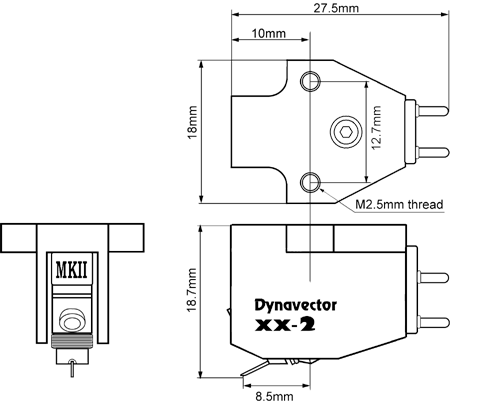
Specifications
| Type | Low output moving coil cartridge with Alnico magnet and Flux damper |
| Output Voltage | 0.28mV (at 1KHz, 5cm/sec.) |
| Channel Separation | 30 dB (at 1KHz) |
| Channel balance | 1.0 dB (at 1KHz) |
| Frequency response | 20 – 20,000Hz (± 1dB) |
| Compliance | 10 mm/N |
| Tracking force | 1.8 – 2.2 g |
| Impedance | 6 ohms |
| Recommended load impedance | > 30 ohms |
| Cantilever | 6mm length 0.3 mm dia. solid boron |
| Stylus tip | PF Line contact shape, stylus radius: 7 x 30 micron |
| Weight | 8.9 g |
